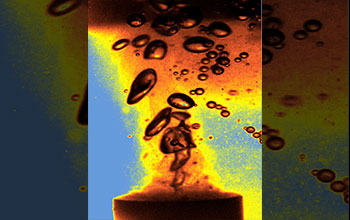Multimedia Gallery
Gas bubbles form and collapse when a liquid is energized by ultrasound
Gas bubbles form and collapse when a liquid is energized by ultrasound.
More about this Image
When a gas bubble in a liquid is excited by ultrasonic acoustic waves, it can emit short flashes of light, suggesting extreme temperatures inside the bubble. These flashes of light are known as "sonoluminescence" and occur as the bubble implodes, or cavitates.
Chemists, supported by the U.S. National Science Foundation (grant CHE 0079124), have for the first time measured the chemical reactions and light emission from a single water bubble excited by sound waves.
The findings were reported in the July 25, 2002, issue of Nature. Read more in the NSF press release Light from gas bubbles: Sonoluminescence measured. (Year of image: 2000)
Credit: K.S. Suslick and K.J. Kolbeck, University of Illinois
Images and other media in the National Science Foundation Multimedia Gallery are available for use in print and electronic material by NSF employees, members of the media, university staff, teachers and the general public. All media in the gallery are intended for personal, educational and nonprofit/non-commercial use only.
Images credited to the National Science Foundation, a federal agency, are in the public domain. The images were created by employees of the United States Government as part of their official duties or prepared by contractors as "works for hire" for NSF. You may freely use NSF-credited images and, at your discretion, credit NSF with a "Courtesy: National Science Foundation" notation.
Additional information about general usage can be found in Conditions.
Also Available:
Download the high-resolution JPG version of the image. (1.6 MB)
Use your mouse to right-click (Mac users may need to Ctrl-click) the link above and choose the option that will save the file or target to your computer.

